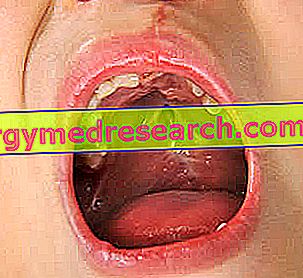Generality
Cleft palate is a congenital malformation that affects the soft palate and / or hard palate, causing, on the latter, the presence of a cracking of variable size.
Generally, it is associated with another congenital malformation of the face: the so-called cleft lip (or cleft lip or cleft lip).

The precise causes of cleft palate are unknown. According to most doctors and researchers, its onset would be due to a combination of genetic and environmental factors.
The presence of cleft palate can lead to difficulties in sucking mother's milk and eating, speaking problems, dental problems and predisposition to otitis of the middle ear.
Cleft palate is a malformation that is difficult to identify before birth. His birth diagnosis, on the other hand, is practically immediate and requires a simple physical examination.
Currently, cleft palate is a treatable condition with excellent results. The main treatment is surgical and consists in closing the crack on the palate.
What is cleft palate?
Cleft palate is a congenital malformation, belonging to the category of oro-facial clefts, which is characterized by the presence of a cleft at the palate (or roof of the mouth).
Extended to the nose, this crack on the palate can involve the hard palate - that is, the bony portion of the roof of the mouth - and / or the soft palate - that is, the muscle-membranous portion of the roof of the mouth.
Medical meaning of cleft and facial cleft
The word schisi is synonymous with spacing . In medicine, this term indicates the presence, on an anatomical organ, of a tissue fissure along the median line, consequent to a welding error.
Typically, cleft is a congenital condition (ie present since birth). Thus, the welding error, which leads to the appearance of tissue cracking, takes place during embryonic development.
The oro-facial clefts are a group of malformations that involve the presence, on the mouth or on the face, of a fissure or tissue spacing of variable amplitude.
The phenomena of oro-facial cleft can affect the palate (cleft palate), the upper lip (cleft lip), ears, eyes, nose and forehead.
PALATOSCHISI, LEPORINO LIPS AND LABIOPALATOSCHISI
The cleft palate can present itself or in association with another fairly common and known oro-facial cleft: the so-called cleft lip . Those suffering from cleft lip have one or two slits on the upper lip, which can reach the floor of the nasal nostrils.
The association between cleft palate and cleft lip is a fairly common medical condition, which is called cleft lip and palate .
Epidemiology
In the so-called Western World, cleft palate, associated with the cleft lip, affects 1-2 newborns every 1, 000 babies.
In important countries such as the United Kingdom or the United States, it appears to be one of the most common physical malformations of a congenital nature.
Cleft palate alone is more common in the female population; according to some statistical researches, newborn females with cleft palate would be about twice as many as male babies with the same anomaly.
Cleft palate - and, more generally, all forms of oro-facial cleft - are more widespread in Asian populations, Caucasian whites and so-called Native Americans, while they are uncommon among Africans and African Americans.
Causes
In humans, the palate is formed between the sixth and ninth week of fetal development ; in particular, its formation results from a process that sees the tissues of the future aimed to grow from the sides of the face towards the center of the latter, and weld together when reaching each other.
Thus, the formation of the palate - as well as the other structures present at the center of the face (nose, lips, etc.) - represents the final stage of the embryonic process of creation of the face.
In people with cleft palate, welding of tissues that, coming from the sides of the head, must give rise to the palate, does not happen or occurs incorrectly. Failure to weld the aforementioned tissues leaves a crack, which is the characteristic cracking present on the palate of people with cleft palate.
WHAT DOES THE PALATOSCHISTER DETERMINE?
The precise causes of cleft palate are still unknown.
According to the researchers' most reliable hypotheses, the malformation in question would be due to a combination of genetic factors and environmental factors .
With regard to genetic factors, researchers believe that cleft palate may depend, at least in part, on one or more DNA mutations / anomalies taking place shortly after conception (ie in the first moments of embryonic development). Studies carried out in this regard have shown that, in the human genome, there are genes (short but significant DNA sequences), whose alteration (due for example to a mutation) is responsible for a wrong development of facial features (palate included) .
As for environmental factors, scholars believe that some behaviors or conditions of the mother, during the period of pregnancy, may compromise the normal development of the palate formation processes. Among the behaviors and conditions of the mother during pregnancy, which could have a key role on the appearance of the cleft palate, we note:
- Smoking . In this regard, the numbers speak for themselves: children with cleft lip or another cleft-facial cleft, who were born to women smokers, are more than children with the same malformations born of non-smoking women. Based on this observation, the experts concluded that women who smoke during pregnancy have a greater tendency to give birth to children with cleft palate than non-smoking women;
- Use certain drugs . Among the incriminated medicines, we note: the antiepileptics / anticonvulsants (valproic acid, tapiramate etc.), the medicines for acne based on accutane and methotrexate.
On antiepileptic / anticonvulsants it is worth adding that the assumptions considered most dangerous are those that occur during the first trimester of pregnancy;
- Diabetes . Statistical studies have shown that women with diabetes are more likely than non-diabetic women to give birth to children with cleft lip;
- Drinking alcohol . The same applies to smoking;
- Obesity . Among obese women during pregnancy, researchers observed a greater propensity to give children with a cleft lip;
- Advanced age . The advanced age of the pregnant woman is a condition associated, in general, with a greater probability of genetic defects affecting the fetus;
- Folic acid deficiency .
Cleft palate risk factors (from the mother's point of view): |
|
IS IT A HEREDITARY CONDITION?
In the past, some researchers have advanced the hypothesis that the cleft palate may have, in some cases, an inherited origin. In support of this hypothesis they reported the case of several family nucleuses, in which the malformation in question occurred between the various generations.
However, subsequent research, aimed at proving the above, have failed; therefore, experts have ruled that some hereditary component may affect the development of the cleft palate.
Symptoms, signs and complications
The typical symptoms of cleft palate consist of:
- Difficulty sucking mother's milk and eating . In the human being, the correct anatomy of the mouth is essential to suck milk from the mother, during the first years of life, and to take food, at a later stage.
A buccal malformation such as cleft palate makes it difficult, in those affected, the suction of milk from the maternal breast, in infants, and the intake of food, in the largest untreated subjects.
- Speech problems . People with cleft palates tend to express themselves in an unclear way and, for this reason, to have different difficulties in relating to others.
Furthermore, as they age, they have a tendency to develop a nasal voice.
- Teeth problems . Cleft palate often develops an anomalous dentition, misaligned and easily subject to caries.
- Recurrent ear infections ( otitis ). The cracking present on the palate of those suffering from cleft palate is responsible for a more or less severe deformation of the Eustachian tube. This deformation of the Eustachian tube predisposes the middle ear of cleft palate to accumulate liquid inside it.
The abnormal accumulation of fluid in the middle ear promotes bacterial proliferation and the consequent appearance of otitis.
Failure to treat otitis leads, in the long run, to a hearing loss, sometimes even very evident.
Diagnosis
In general, the diagnosis of cleft palate occurs shortly after birth, by means of a simple physical examination . Moreover, the cleft of the palate that characterizes the malformation in question is evident from the first moments of life.
PRENATAL DIAGNOSIS: IS IT POSSIBLE?
The various ultrasounds of the fetus in utero, to which normally pregnant women undergo during the 9 months of pregnancy, are almost never able to show any malformations on the palate. Therefore, a prenatal diagnosis of cleft palate, through prenatal ultrasound examinations, is impossible or at least unlikely.
That said, the doctors may still have suspicions in front of a prenatal ultrasound scan, when the latter shows the presence of a cleft lip. As mentioned earlier, in fact, cleft lip and cleft palate are very often concomitant malformations.
Therapy
The treatment of cleft palate includes a series of surgical interventions and medical therapies aimed at improving the symptomatology (therefore the difficulties in speaking, recurrent otitis, etc.).
SURGERY

The first operation is usually scheduled between the 6th and 12th month of life - therefore quite early - and involves the closure of the crack on the palate .
With regard to the first cleft palate operation, it is important to note that:
- The sooner the crack is closed on the palate, the better the long-term results will be;
- The palate should be closed, in any case, within the first 18 months of life. Postponing the operation beyond this limit could have negative repercussions on the final result.
Subsequent surgical procedures take place when the patient is older (adolescent and late adolescent age) and are intended to further refine the appearance of the palate and adjacent anatomical structures.
The number of surgeries a cleft palate must undergo depends primarily on the severity and location of the malformation. This means that the more severe the palate anomaly, the more likely it is that a long series of operations is needed.
MEDICAL THERAPIES
Medical therapies implemented in the event of cleft palate include dental care, treatment and prevention of otitis, a therapy focused on improving speech and language skills etc.
WHAT SPECIALISTS DO THE PALATOSCHISIS TREAT?
Cleft palate treatment involves a team of specialists, who work closely together for a common purpose: the good of the patient.
Among the professional figures that generally deal with people with cleft palate, are:
- The plastic surgeon. He is the specialist in charge of assessing the malformation of the palate and establishing the most appropriate surgical treatment.
- The otolaryngologist. It is the figure that is responsible for the evaluation of ear problems, the search for a solution to the accumulation of fluid in the middle ear and the planning of the most adequate therapy in case of otitis.
- The oral surgeon (or odontostomatologist). It is the specialist who, together with the cosmetic surgeon, provides for the repair of the abnormal palate, with the final aim of eliminating or at least greatly reducing the difficulties in eating.
- The orthodontist. He is the specialist in charge of giving the teeth a normal, aligned appearance.
- The dentist. It is the professional who takes care of caries, in order to preserve teeth.
- The prostodontist. It is the specialist who creates dental prostheses for those patients with cleft palate who develop very serious dental problems.
- The speech therapist. He is the expert who has the task of improving language skills.
- The psychologist. It is the figure that has the task of relating to the patient's family, to understand what the mood of the entire family unit is.
Prognosis
Thanks to modern surgical techniques, today the cleft palate presents a prognosis, in most cases, favorable.
In fact, although they last several years, cleft palate treatments guarantee excellent results, so that many patients, at the end of treatment, tend to have a normal-looking face, to speak clearly and to feed themselves adequately and without problems.
Prevention
As long as its triggering causes are not clear, the cleft palate will remain an impossible condition to prevent.
WHAT CAN YOU DO?
To reduce the risk of giving birth to a cleft palate child, doctors advise pregnant women to control the alleged environmental friendly factors, therefore they recommend: not smoking, controlling body weight, monitoring blood sugar and avoiding intake of those drugs associated with the onset of cleft palate (anticonvulsants, anti-acne based accutane etc.).



